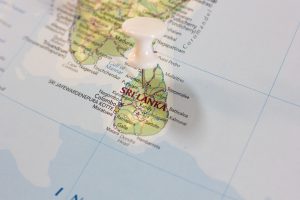Sri Lanka has been caught in a tug of war between India and China. Most recently, a Chinese maritime research vessel, Shi Yan 6, was expected to enter Colombo for research in purposes, in collaboration with Sri Lanka’s National Aquatic Resources Research and Development Agency (NARA).
NARA had earlier indicated that Shi Yan 6 will be in Sri Lanka “as per the agreement reached with the University of Ruhuna.” However, the Sri Lankan university announced its exit from the project. The University of Ruhuna provided various logistical reasons for pulling out of the research partnership with the Chinese vessel.
Given India’s objections to the Chinese ship docking in Colombo for a month, Sri Lanka is reported to have asked China “to defer the visit.” But China insisted on sticking to the original schedule in October-November and demanded that the ship be allowed to dock in Sri Lanka. Sri Lankan Foreign Minister Ali Sabry said that Sri Lanka had “not given permission to the Chinese vessel Shi Yan 6, as Indian security concerns were important to the island nation.” But he added that “negotiations were going on, and if the vessel complied with the standard operating procedures of Sri Lanka, then there would be no problems.”
The United States, too, took up the issue with Sri Lanka. As per media reports, U.S. Under Secretary of State for Political Affairs Victoria Nuland met Sabry in New York on the sidelines of the U.N. General Assembly last month, and aired concerns about the docking of the Chinese research vessel. But Sabry is reported to have remarked that Sri Lanka has established a standard operating procedure that is to be to be complied with by any foreign ship and aircraft entering their territory. As per Sri Lanka’s “even-handed approach,” the minister said that it could not “exclude China.”
While speaking earlier in September at an event hosted in New York by the Carnegie Endowment for International Peace, Sri Lankan President Ranil Wickremesinghe had said that “There are no spy ships in Sri Lanka. I don’t know if anyone can establish a spy ship.” He went on to describe the Chinese ships as “research vessels” that have been coming to Sri Lanka for the last decade, as per an agreement between the Chinese Academy of Sciences and Sri Lanka’s national aquatic research agency.
Perhaps an indication of the creeping Chinese influence on the Sri Lankan leadership, he also criticized AUKUS – an agreement between the U.S., U.K., and Australia to equip the latter with nuclear-powered submarines – calling it “a military alliance moved against one country – China” and “a strategic misstep.” Wickremesinghe also took the opportunity to ridicule the concept of the “Indo-Pacific,” suggesting that new coinage is an “artificial framework” and that “nobody knows what’s Indo-Pacific.”
The current controversy is not a unique one. Last year, there was quite a ruckus around another Chinese vessel, the Yuan Wang 5, that was considered to be a ballistic missile and satellite tracking ship that docked at Hambantota Port in Sri Lanka’s southern coast for a week starting on August 16, 2022. Because of Indian concerns, Sri Lanka, like this year, had asked China to postpone the ship’s arrival but cleared it for docking later on the condition that the ship will “keep the Automatic Identification System (AIS) switched on within the Exclusive Economic Zone (EEZ) of Sri Lanka and no scientific research to be conducted in Sri Lankan waters.” Sri Lankan authorities reportedly said that the clearance was given to the vessel merely for replenishment purposes.
In that case, the Indian concern was that the Yuan Wang 5, with an aerial reach of about 750 km, had radar monitoring ports in the southern Indian states of Kerala, Tamil Nadu, and Andhra Pradesh. While docked in Sri Lanka, the Chinese vessel would, the Indian argument ran, be in a position to snoop on many critical installations in southern India.
China reportedly has seven such tracking ships, which can operate in the Pacific, Atlantic, and Indian oceans. China’s ship-based monitoring adds to China’s land-based tracking capabilities. In addition to Indian concerns about the Yuan Wang 5, the U.S. State Department also noted that the Chinese ship is part of the People’s Liberation Army (PLA) Strategic Support Force, “a theater command-level organization established to centralize the PLA’s strategic space, cyber, electronic, information, communications, and psychological warfare missions and capabilities.”
According to media reports, between 2019 and 2023, there have been 48 Chinese scientific research vessels that have docked in the Indian Ocean region, with deployment mostly around the area of the Bay of Bengal and the Arabian Sea toward Persian Gulf.
China can continue with its claims that these are scientific missions, but the Indian suspicion of China using these missions for military purposes, including intelligence gathering, is not going to vanish. Meanwhile, smaller countries like Sri Lanka are playing their own geopolitical games to get the most from both India and China.
Even if temporary, these incidents cause concern in India about Sri Lanka. Indian Defense Minister Rajnath Singh was scheduled to travel to Sri Lanka in early September but the meeting was postponed at the last minute due to “unavoidable circumstances.” It is not certain if it was linked to the news of the Chinese ship possibly docking in Sri Lanka, but it is very likely that the timing was not a mere coincidence. The postponement was possibly meant to convey India’s displeasure to Colombo.

































